Location is all-important when selecting landscape plants
Now is the beginning of the fall planting season. Depending on what you are planting, this window of opportunity might last until about mid-December depending on the weather. Mid-December is when the cold winter weather starts and lasts until about mid-January.
Can we plant outside of this window? Of course. But the further we plant outside of this window, the more difficult success becomes. Now is the optimum planting time during the fall.
Now is also the time when nurseries begin their fall planting sales. Remember, plant location is all-important when selecting landscape plants and matching them to their correct landscape microclimate.
True desert plants — those originating from the desert Southwest primarily — can usually be planted in harsh microclimates such as full exposure on the west and south sides of homes. Examples of those plants are some of the acacia, mesquite and palo verde as well as others.
Many of our ash trees, honey locust, Idaho locust just flat out can’t handle these extreme microclimates when it gets hot. They seem to handle it OK when the weather is cool but start showing intolerance when it gets hot, resulting in leaf scorch, poor growth, or brown leaves.
Trees and shrubs are better able to handle these south and west exposures in full sun when planted in improved soils. Improving the soils at the time of planting and then spreading a thin layer of compost near them every one or two years gives these plants a fighting chance at surviving high summer temperatures. Planting in hot locations, such as close to south- or west-facing walls, can be difficult to get much of anything established but your best opportunity for success is planting in the fall.
Bottom line? Amend the soil at planting time to at least three times the diameter of its container. Choose the best microclimate for it to grow in. Microclimates in the desert are profoundly different from anywhere else in the country. Before buying a tree, do your homework.
Where to look for ideas? Try Dr. Chris Martins tree and shrub website from Arizona State University. I will publish my own tree and shrub microclimate recommendations for the Mojave Desert toward the end of September.
Q: I have four oleanders in front of my house (facing west), and they are all thriving. I also have a row of oleanders on the north side of my property that are also doing well. However, there were two oleanders that withered and eventually died. Watering did not seem to be the issue.
A: If you don’t think it is drought then it could be a bacterial disease called oleander leaf scorch. Although rare, it is fatal for oleander with no cure in sight.
Try cutting them back this winter to about 6 inches above the ground and watering them every 10 days with a hose. Make sure to apply enough water to wet the roots 18 inches deep. This may require constructing a 4-inch-high donut around the plants or leaving a landscape sprinkler on to wet the soil for an hour or more.
If these plants begin to sucker again with healthy growth then it was lack of water. If not, then it is probably oleander leaf scorch.
If it doesn’t grow back either replace it or plant something different in that spot. Oleander leaf scorch is spread by insects called sharpshooters that look and suck plants juices like leafhoppers. Once infected the plant should be removed to prevent the spread of this disease to other plants by the same insect.
Q: I have a 7-year-old bottle tree in my backyard. It is now taller than my one-story house. Do you have any suggestions on how to prune this bottle tree or should I replace it?
A: You already learned this Australian “bush” tree can get big. It has a mature height topping around 60 feet. Your single-story home is around 15t to 20 feet tall at the roof. Shading the walls and windows is more important than shading the roof. For that reason, choose trees with a mature height around 20-ish feet plus or minus five feet.
A bottle tree won’t use much water when it’s young, but it will when it gets older. Besides that, having a big tree on your property in later years will look funny when compared to a one-story home. It is totally out of scale on your property. Wrong tree selection for your home.
Because of bottle trees upright shape, it will not look right when you try to reduce its height by pruning. Some trees can be pruned to reduce their height, but not a bottle tree. Replace it with a 20-foot tree more compatible in size with your single-story home.
Make sure any major tree chosen can survive winter lows close to 20 degrees. Planting distance from the house varies; plant no closer than around half its mature height. Closer than this will require some pruning to keep it away from the house. Keep irrigation water 3 feet from the home to avoid potential chemical damage to the foundation.
Before selecting a tree, questions need to be considered: What do you want from this tree? Which of these is most important? Is it for summer shade? Privacy? Beauty? Lower water costs? Are you planting it in full sun or partial shade? Once a tree is planted, you are committed.
Q: We think our ornamental pear tree had fire blight disease. This spring it had a dead branch at the top, so we cut it off and now the tree seems to be dying. Is there anything we can do to save the tree?
A: Fire blight is a particularly virulent bacterial disease that can cause rapid tree death in Asian pears, European pears including ornamental pear, apples and quince. It is called fire blight because of the blackening and death to leaves and stems during summer months after the infection. I see it starting to appear in late spring (May) in susceptible fruit trees.
The problem is European and ornamental pear leaves turn black when they are damaged by anything. So, using the black leaf color attributed to fire blight doesn’t always work when it comes to pears of any kind.
That being said, I would rather be safe than sorry. The best way to contain that disease is to prune it out when first seen with sanitized pruners and deep cuts and dispose of the suspected fire blight off the property as soon as possible. I like to recommend cutting at least 12 inches below the damaged area and sanitizing between cuts.
Q: I have a small pond with a waterfall containing four goldfish and two turtles. It accumulates their waste plus some leaves which blow in it. I would like to use about a fourth of the water every other day to water some bushes, fruit trees, palm trees and possibly garden plants. This will help keep the pond clean, and the water is probably nutrient rich. Any issues or problems you can see with this?
A: Nope. It’s a good idea. Just like an aquarium you must empty about one third of it periodically and refill it depending on the animal population. You are right and disposing of fish waste regularly is a basic tenet of aquaculture.
Q: I have a problem with what I call roly-poly. These are hard-shelled little critters that roll into a ball when touched. They are coming into my house. How do I rid myself from them? I tried bug spray everywhere, but it only works temporarily.
A: Roly-polies — aka pill bugs, slaters, doodle bugs — are not insects. Like cockroaches, they prefer where there is moisture. They also like it where it’s cool. Gardeners know them in strawberries and other soft, moist fruits, vegetables and leaves. They are known to escape the heat of the day by burrowing under mulch on the cooler moist soil surface.
Just about any insecticide will kill them, but the primary recommendation is to seal cracks and crevices around the home where they can be entering. Anecdotally people tell me they have used stale beer as a trap like trapping snails and slugs, cardboard in a similar way and diatomaceous earth which seems to be a catchall for many organic gardeners.
Bob Morris is a horticulture expert and professor emeritus of the University of Nevada, Las Vegas. Visit his blog at xtremehorticulture.blogspot.com. Send questions to Extremehort@aol.com.





























